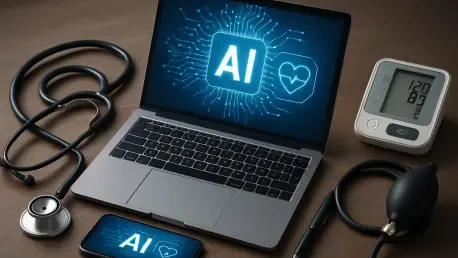What happens when life feels like a constant juggling act—caring for aging parents, raising young children, and grappling with healthcare costs that seem to climb by the day? For millions of Gen X and Millennials, the answer lies in a surprising ally: health AI tools. These generations, often caught in a relentless caregiving squeeze, are turning to technology to navigate a system that feels increasingly out of reach. This growing trend isn’t just about convenience; it’s a lifeline for those stretched thin by time and financial pressures.
The significance of this shift cannot be overstated. With over 70% of Gen X and Millennials showing interest in AI-driven healthcare solutions—compared to just 56% of the broader population—these groups are redefining how care is accessed and managed. Their embrace of digital innovation reflects a deeper struggle: balancing dual responsibilities while facing systemic challenges like skyrocketing costs and limited time. This story uncovers the forces driving this adoption, the real-life impact on families, and what it means for the future of healthcare.
Caught in the Caregiving Crunch: A New Reliance on Tech
Picture a 40-something Gen X parent rushing between a pediatrician appointment for their child and a pharmacy run for their elderly mother’s medication, all while worrying about an impending medical bill. This scenario is all too common for the so-called sandwich generation, who find themselves sandwiched between two sets of caregiving demands. Health AI tools, from symptom checkers to care navigation apps, have emerged as a critical resource, offering quick answers and streamlined solutions when time is a luxury few can afford.
The reliance on technology stems from necessity rather than mere curiosity. Many in these age groups are managing packed schedules alongside fears of unaffordable healthcare, with 75% of Americans expressing anxiety over costs according to recent surveys. AI provides a way to cut through red tape—whether it’s finding a nearby specialist or getting a preliminary diagnosis—allowing these individuals to focus on their loved ones rather than endless logistics.
This tech-driven approach marks a departure from traditional healthcare models, where long wait times and complex systems often add to the burden. For Gen X and Millennials, adopting AI isn’t just about keeping up with trends; it’s about survival in a world where every minute and dollar counts. The tools are becoming a trusted partner in managing the chaos of modern family life.
The Sandwich Generation’s Healthcare Dilemma
Gen X, born roughly between 1965 and 1980, and Millennials, born between 1981 and 1996, face a unique set of pressures that make health AI particularly appealing. Often responsible for both young children and aging parents, they are squeezed by time constraints that leave little room for navigating a fragmented healthcare landscape. This dual role amplifies stress, especially when paired with job insecurity and the ever-looming threat of unexpected medical expenses.
Financial strain adds another layer of complexity to their situation. With 70% of these generations concerned about out-of-pocket costs and high insurance premiums, the fear of being unable to afford care if circumstances change is real. Many are forced to make tough choices, with nearly 30% of Americans admitting to delaying or skipping recommended treatments due to affordability barriers, a reality that hits the sandwich generation especially hard.
These challenges create fertile ground for tech solutions that promise efficiency and accessibility. Unlike older generations who may cling to traditional care models, Gen X and Millennials are more open to alternatives that fit their fast-paced lives. Their willingness to experiment with AI reflects not just desperation, but a pragmatic search for tools that can lighten an otherwise overwhelming load.
Driving Forces Behind AI Adoption
Several factors fuel the rapid uptake of health AI among these demographic groups. A striking 70% of Gen X and Millennials are open to AI-assisted diagnostics and care navigation tools, far outpacing the general population’s 56% interest. This gap highlights a generational readiness to lean on technology as a practical solution to pressing healthcare needs, driven by a blend of necessity and digital comfort.
Time scarcity plays a pivotal role in this trend. With dual caregiving responsibilities, these individuals often lack the hours needed to research doctors, schedule appointments, or even sit in waiting rooms. AI tools that can recommend providers or offer instant symptom assessments are seen as time-savers, enabling them to address health concerns without derailing their already packed days.
Digital familiarity further accelerates adoption. Unlike older generations who may view technology with skepticism, Gen X and Millennials grew up alongside the internet and smartphones, making AI integration feel like a natural extension of their daily lives. Whether it’s using an app to track a parent’s chronic condition or accessing virtual consultations, their tech-savvy nature positions them as frontrunners in this healthcare revolution.
Voices from the Field: Insights and Experiences
Expert opinions shed light on why this shift is gaining momentum. Thom Bales, a health services advisory leader, notes that Gen X and Millennials view AI as a “call to simplifying their life,” capturing the essence of their motivation. This perspective underscores how technology is less about novelty and more about providing tangible relief in a world of endless demands.
Real-world experiences bring this data to life. Consider a Millennial in their late 30s, managing a full-time job while coordinating care for an elderly father with diabetes. By using an AI-powered app to monitor medication schedules and flag potential issues, they can stay ahead of emergencies without constant trips to the doctor. Such stories, echoed by 73% of these generations expressing interest in AI care navigation, reveal the profound impact of these tools on daily routines.
These personal accounts, paired with expert insights, paint a picture of a demographic turning to innovation out of necessity. The human element behind the statistics—parents desperate for solutions, children seeking peace of mind—demonstrates that AI adoption is not just a trend, but a deeply personal response to systemic shortcomings in healthcare access and affordability.
Navigating Health AI: Practical Steps for Integration
For those in Gen X and Millennials looking to incorporate health AI into their lives, a thoughtful approach is essential. Begin by seeking out platforms endorsed by reputable healthcare providers to ensure reliability and accuracy. Tools that integrate with existing medical records offer a seamless way to maintain continuity, avoiding the pitfalls of fragmented data that could lead to errors.
Prioritizing privacy is another critical step. While AI offers convenience, sharing sensitive health information requires caution. Opt for applications with transparent data policies and robust security measures, and always use these tools as a starting point—such as for symptom analysis—while consulting a physician for definitive diagnoses or treatment plans. This balance ensures that technology supports rather than replaces professional care.
Finally, focus on education and gradual adoption. Start with simple features like appointment scheduling or medication reminders before diving into more complex diagnostic tools. By taking measured steps and staying informed about updates in AI capabilities, individuals can harness these innovations to manage their multifaceted healthcare responsibilities with greater confidence and control.
Final Reflections
Looking back, the journey of Gen X and Millennials through the healthcare maze reveals a profound shift toward technology as a lifeline. Their embrace of AI tools stands as a testament to resilience in the face of caregiving burdens and financial fears. Each step they took to integrate digital solutions mirrors a broader quest for efficiency in a system that often seems stacked against them.
As this story unfolds, actionable paths emerge for others to follow. Exploring trusted AI platforms, safeguarding personal data, and blending tech with traditional care become not just strategies, but necessities for navigating modern challenges. These steps offer a blueprint for anyone caught in similar binds, proving that innovation can ease even the heaviest loads.
Moving forward, the focus shifts to scaling these solutions equitably. Ensuring that health AI reaches beyond tech-savvy generations to all who need it becomes the next frontier. This evolution promises a future where technology doesn’t just simplify life for some, but transforms healthcare access for everyone, paving the way for a more inclusive system.









